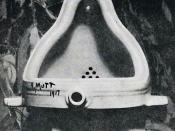"It's very difficult to escape from the prison of tradition. Education is so strong, it holds you like a chain. I didn't get completely free then, but I tried. I unlearned to draw. I had to forget with my hand." -Marcel Duchamp The legacy of an artist can be judged by two merits, first the work they left behind, and second the influence of those works on later artists. The evolution of European and American art throughout the 20th century was both controversial and revolutionary. It brought about changes that were not only visually innovative, but also pioneering in the way people perceived art. One of the most influential artists of this time period was Marcel Duchamp. A French native born in 1887 of a middle class art family, Duchamp attempted and succeeded at experimenting with various movements such as fauvism and cubism. However, Duchampt saw no virtue in making a habit of any one style, therefore abandoning painting, shifting his focus to what is now called "ready-mades".
Responsible for this creation of ordinary objects that he signed, titled, and considered to be finished pieces of art, Duchamp ever changed the course of modern art. Never before had the world of art even conceived an idea like this. The concept was an attack on previous traditions of western art and provided fresh inspiration for 20th century art.
Duchamp began creating "ready-made" sculptures in the 1910's. The previous movements in art leading up to Duchamp; impressionism, fauvism, and cubism, all were controversial because their style and subject matter were executed in a way that had never been explored, at the same time challenging traditional standards. Duchamp, like founders of these styles, sought to rebel against the art of the time period. Instead of simply changing the look of art,


